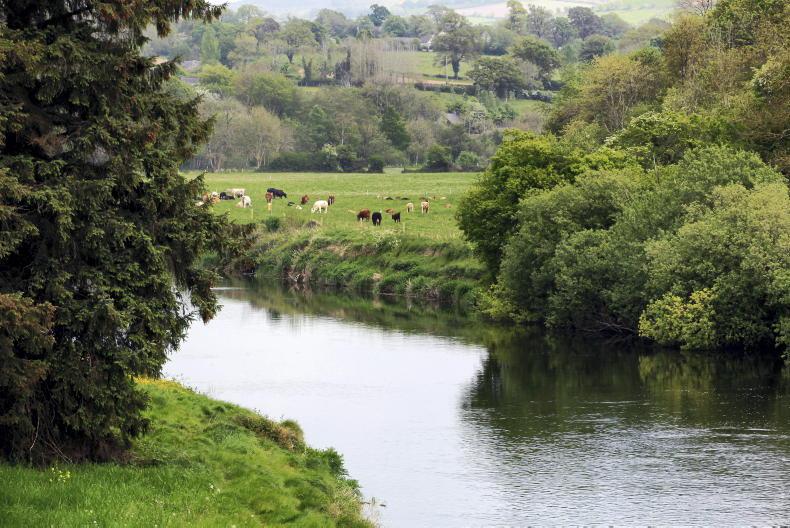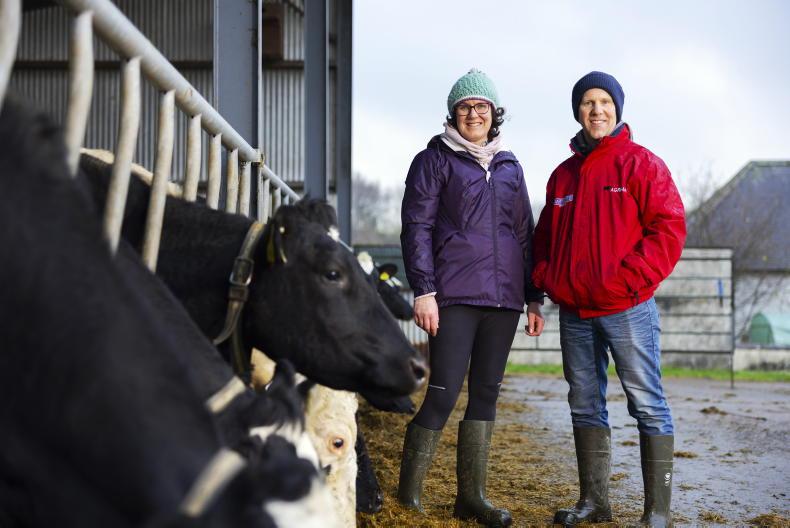The Nitrates Directive is in place since 1991 which aims to protect surface water from pollution by agricultural sources and to promote good farming practice.
The current fifth Nitrate Action Programme (NAP) covers the period from 1 January 2022 to 31 December 2025. Our application to Europe for the sixth NAP and the derogation decision on the 170/kg organic N/ha stocking rate limit will take place this year.
All going well, this process will be finalised in December and we will know how things have worked out in January 2026, with a new Good Agriculture Practice (GAP) regulations coming into force then.
Additionally, this year the EPA will publish its report on water quality in Ireland that will cover the years 2022, 2023 and 2024; hopefully this will show improvements in water quality.
With all this going on, now is a good time to look at the processes that influence nitrate loss to water, and this is the first in a series of articles that will look further into this.
Nitrates vs nitrogen
You could well ask why the regulation is called the ‘Nitrates’ Directive and not the ‘Nitrogen’ directive.
The simple answer is that Nitrate (NO3–)
is the form of nitrogen that easily dissolves in water and can cause problems to both human health and ecology in water when concentrations become too high.
Nitrogen exists in many forms and is all around us.
In its simplest form, nitrogen gas (N2), makes up 78% of the air.
This amounts to 80,000,000kg N for each hectare of the earth’s surface and is a very stable form of N that can only be utilised by very few living organisms.
Probably the best known are nitrogen-“fixing” bacteria on the roots of legumes such as clover or beans.
These can fix 100-150kg of N/ha in a year when conditions are favourable.
Nitrogen is continually changing from one form to another in what is referred to as the nitrogen cycle.

Eddie Burgess, Agricultural Catchments Programme, Teagasc. \ Donal O' Leary
It is an “essential” element, and along with carbon (C), hydrogen (H) and oxygen (O) makes up 96% of all living matter.
For a growing plant to take up nitrogen, it needs to be in the form of either ammonium (NH4+) or nitrate (NO3–), both mineral forms of N.
Animals get nitrogen from their diet in the form of protein.
Before the widespread use of fertilisers, such as calcium ammonium nitrate (CAN), the levels of output on both tillage and livestock farms were limited by the supply of plant-available N, with most of this coming from the soil naturally.
Soil contains a large amount of N in the form of organic matter, which is quite stable and is not available for plants to use.
The amount of N contained in soil organic matter varies considerably, with arable soils typically containing between 2,000kg/ha and 4,000kg/ha and permanent grassland on mineral soils containing between 5,000kg/ha and 15,000kg/ha.
A small portion of the N contained soil organic matter is “mineralised” each year when conditions are good (approximatley 150 kg N/ha). This is a microbial process and temperature, air availability and pH all have an influence.

Probably the best known are nitrogen-“fixing” bacteria on the roots of legumes such as clover or beans. / Donal O' Leary
The lower rates of chemical N required on barley sown into what was previously long term grassland show that mineralisation of soil organic matter has occurred.
This mineralisation releases N in a plant-available form, ammonium, which is held onto by clay and organic matter, and is less mobile than nitrate.
In warm and well-aerated soils however, more bacteria will progressively transform ammonium to nitrate, which can also be taken up by growing plants.
But as nitrate is very easily dissolved in water and is not held onto by clay like ammonium, excess nitrate not taken up by a growing crop can leach down through the soil profile and end up being lost to groundwater.
Mineralisation of soil organic matter and bacterial fixation on legume roots are probably not the first potential sources of nitrate that come to mind considering nitrate leaching.
More obvious sources include chemical fertiliser and organic manure applications, and the dung and urine deposited by animals grazing on the land.
People often ask which source is more risky for nitrate loss to water, but given the transformations of N that take place it’s not simple to distinguish between one source and another.
Nitrate in the soil that is surplus to crop requirement is at risk of leaching, regardless of where it comes from.
What is key to reducing nitrate leaching is minimising surplus N above crop requirements at times when water is moving down through the soil. The autumn period is typically the time of year that the risk of this happening is highest.
Edward Burgess works with the Agricultural Catchments Programme, which is informing many actions in Teagasc’s Better Farming for Water campaign.
The Nitrates Directive is in place since 1991 which aims to protect surface water from pollution by agricultural sources and to promote good farming practice.
The current fifth Nitrate Action Programme (NAP) covers the period from 1 January 2022 to 31 December 2025. Our application to Europe for the sixth NAP and the derogation decision on the 170/kg organic N/ha stocking rate limit will take place this year.
All going well, this process will be finalised in December and we will know how things have worked out in January 2026, with a new Good Agriculture Practice (GAP) regulations coming into force then.
Additionally, this year the EPA will publish its report on water quality in Ireland that will cover the years 2022, 2023 and 2024; hopefully this will show improvements in water quality.
With all this going on, now is a good time to look at the processes that influence nitrate loss to water, and this is the first in a series of articles that will look further into this.
Nitrates vs nitrogen
You could well ask why the regulation is called the ‘Nitrates’ Directive and not the ‘Nitrogen’ directive.
The simple answer is that Nitrate (NO3–)
is the form of nitrogen that easily dissolves in water and can cause problems to both human health and ecology in water when concentrations become too high.
Nitrogen exists in many forms and is all around us.
In its simplest form, nitrogen gas (N2), makes up 78% of the air.
This amounts to 80,000,000kg N for each hectare of the earth’s surface and is a very stable form of N that can only be utilised by very few living organisms.
Probably the best known are nitrogen-“fixing” bacteria on the roots of legumes such as clover or beans.
These can fix 100-150kg of N/ha in a year when conditions are favourable.
Nitrogen is continually changing from one form to another in what is referred to as the nitrogen cycle.

Eddie Burgess, Agricultural Catchments Programme, Teagasc. \ Donal O' Leary
It is an “essential” element, and along with carbon (C), hydrogen (H) and oxygen (O) makes up 96% of all living matter.
For a growing plant to take up nitrogen, it needs to be in the form of either ammonium (NH4+) or nitrate (NO3–), both mineral forms of N.
Animals get nitrogen from their diet in the form of protein.
Before the widespread use of fertilisers, such as calcium ammonium nitrate (CAN), the levels of output on both tillage and livestock farms were limited by the supply of plant-available N, with most of this coming from the soil naturally.
Soil contains a large amount of N in the form of organic matter, which is quite stable and is not available for plants to use.
The amount of N contained in soil organic matter varies considerably, with arable soils typically containing between 2,000kg/ha and 4,000kg/ha and permanent grassland on mineral soils containing between 5,000kg/ha and 15,000kg/ha.
A small portion of the N contained soil organic matter is “mineralised” each year when conditions are good (approximatley 150 kg N/ha). This is a microbial process and temperature, air availability and pH all have an influence.

Probably the best known are nitrogen-“fixing” bacteria on the roots of legumes such as clover or beans. / Donal O' Leary
The lower rates of chemical N required on barley sown into what was previously long term grassland show that mineralisation of soil organic matter has occurred.
This mineralisation releases N in a plant-available form, ammonium, which is held onto by clay and organic matter, and is less mobile than nitrate.
In warm and well-aerated soils however, more bacteria will progressively transform ammonium to nitrate, which can also be taken up by growing plants.
But as nitrate is very easily dissolved in water and is not held onto by clay like ammonium, excess nitrate not taken up by a growing crop can leach down through the soil profile and end up being lost to groundwater.
Mineralisation of soil organic matter and bacterial fixation on legume roots are probably not the first potential sources of nitrate that come to mind considering nitrate leaching.
More obvious sources include chemical fertiliser and organic manure applications, and the dung and urine deposited by animals grazing on the land.
People often ask which source is more risky for nitrate loss to water, but given the transformations of N that take place it’s not simple to distinguish between one source and another.
Nitrate in the soil that is surplus to crop requirement is at risk of leaching, regardless of where it comes from.
What is key to reducing nitrate leaching is minimising surplus N above crop requirements at times when water is moving down through the soil. The autumn period is typically the time of year that the risk of this happening is highest.
Edward Burgess works with the Agricultural Catchments Programme, which is informing many actions in Teagasc’s Better Farming for Water campaign.













SHARING OPTIONS